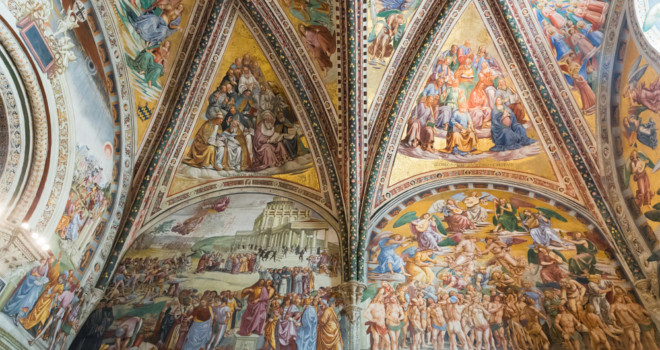Faith & Art
Everyone knows that Western art is profoundly connected to the religious, that sacred themes have permeated influential works of painting, narrative, poetry, architecture, and so forth throughout our history.
The influence of these classical sacred pieces is still felt today, in what is generally agreed to be a post-Christian West. For instance, the most reproduced piece of visual art is Michelangelo’s Creation of Adam from the Sistine Chapel. And the most performed choral piece of music alternates between Mozart’s Requiem and Handel’s Messiah.
Art for All?
It’s
critical here to notice that great religious art engages the admiration and
appreciation not only of the highly cultivated but also of those who are
aesthetically uneducated. For instance, in 1311, the great painter Duccio di
Buoninsegna completed a grand altarpiece for the cathedral of Siena. Before it
was installed, the artwork was surrounded by candles and was carried in a
lengthy procession that included the bishop, the priests, the monks, the
nobles, and all the people. All the shops were closed, and the entire city
celebrated.
Here we have art that was acknowledged to be
aesthetically excellent — that is, great, beautiful art — and it was celebrated
and cherished by the community as a whole, not just by art specialists.
According
to Gaudium et spes, the purpose of
literature and the arts is
to make known the proper nature of man, his problems and his experiences in trying to know and perfect both himself and the world. They have much to do with revealing man’s place in history and in the world; with illustrating the miseries and joys, the needs and strengths of man and with foreshadowing a better life for him.
Now, if we have given up the question of human nature, and its ultimate destiny; if the only knowledge we care about is material measurement, and the only happiness we care about is physical pleasure, then art isn’t going to be able to express anything that we care about. And so artists will just do their own thing, while we continue our obsession with science and hedonism.
Art to Make a Difference
The point is, firstly, if we ever want art to make a real difference to people, as opposed to being a cultured hobby of the few, it must readdress its proper subject matter, which is ultimate reality and truth.
Secondly, believers know that ultimate reality and truth are, in fact, God Himself, which means that Christians must at least be willing to address the divine in their art. Far from diminishing the impact of said art, infusing their faith into their work will enable artists to affect their audience at a deeper level because people fall on their knees before art only when it communicates more than just itself. People fall on their knees before art only when that art expresses and represents the divine.
Art and the Witness of Faith
Now we come to the very touchy subject of art and Christian witness. Since witness happens most obviously through the medium of words, we’ll use literature as the prime example of witnessing to the gospel through art.
To begin with, it is important to establish that evangelization is every Christian’s duty: “Missionary activity, which is carried out in a wide variety of ways, is the task of all the Christian faithful,” (Redemptoris Missio). We also need to acknowledge that proclaiming the gospel is a daunting task and that a lot of us try to rationalize getting out of it somehow.
This
avoidance of witnessing to the Faith, especially in non-private settings (e.g.,
work, politics, education) usually takes one of two forms. It can take the form
of compartmentalization: “I try to keep my faith life and my work life
separate.” This is simply a clever euphemism for a lack of integrity — for
cutting one half of yourself off from the other half.
On the other hand, we may try to get out of evangelizing by appealing to the power of subliminal witness: “I try to let my Christian example speak for itself.” A lot of people like to invoke a saying misattributed to St. Francis: “Preach the gospel always; when necessary, use words.” Here the idea can be that you’ll just automatically live differently because you’re a Christian, and that difference will overflow into all that you do and will serve as a sufficient gospel proclamation. This idea, of course, isn’t true. No example — even a perfect one — can substitute for one mind actively trying to communicate the truth, through signs, to another mind. Further, because we’re sinners, our example leaves a lot to be desired, and so we have to supplement our example with words.
So a similar problem surfaces when it comes
to religious themes in art: people either want to say that art and faith should
be kept completely separate, or they want to say that if an artist is a
Christian, his faith will subliminally infuse his work — without any deliberate
“proselytizing” on his part — and so will radiate the truth of the gospel.
But
again, neither of these approaches is enough.
As we just saw, art has an inherent directedness toward
ultimate truth, and if you intentionally try to separate your art from what you
know to be the ultimate truth (e.g., God, Christ, the Church, heaven and hell),
that’s a betrayal of both your faith and your art.
Also, we can’t put the burden of communicating important truths on
our subconscious. It’s like those people who think, “I’m sure my wife and kids
know I love them, even though I never make a deliberate effort to say it or
show it in any clear way.” Nope. Maybe you do love them, but if you want them
to know it, you’d better figure out how you’re going to let them know. You
can’t just expect it to get across “subliminally.”
If you’re going to communicate something, you must thoughtfully choose a symbol — whether a word, a gesture, or an image — that you think will be effective in conveying it to someone else. So, if you’re going to communicate the Faith in art — that is, if you’re going to live up to your obligations as a Christian and an artist — you must be deliberate about it.
Notice I say “deliberate,” not “explicit.” Art deals with images, not formalized propositions. Our Lord told stories, all of which were designed to communicate saving truth, but they weren’t all equally explicit. Some of them had obvious meanings, which everyone understood at once (such as the parable of the wicked tenants). Some of them had obscure meanings that our Lord explained to only a few (such as the parable of the sower). And some of them had obscure meanings that He didn’t explain at all and are still not immediately clear two thousand years later (such as the parable of the three measures of flour).
Art that is Implicitly Catholic
So, it’s no condemnation to say that a Catholic writer has made his art implicitly Catholic. Walker Percy wrote late in life,
Nor, God forbid, do I feel obliged to write edifying tales where virtue wins out and the Catholic Faith triumphs over high-class ‘secular humanists’ or low-class Mafia types. It usually works better to let the latter win or think he wins. Novelists are a devious lot, Catholic novelists more than most.
An image that, on the surface, is secular or even anti-Catholic, might be best equipped to surprise the reader with Catholic truth or even delight the reader with Catholic irony. Flannery O’Connor has a passage in one of her stories that corresponds to Percy’s description. One of the characters, a rabid anti-Catholic, says, “They got the same religion as a thousand years ago. It could only be the devil responsible for that.” So what is perhaps the Church’s greatest mark of credibility, i.e., her supernatural consistency, is put into the mouth of a critic. Clever, surprising, delightful — and evangelistic.
O’Connor was clear that her aim involved proclamation: “Writers like myself who don’t use Catholic settings or characters, good or bad, are trying to make it plain that personal loyalty to the person of Christ is imperative, is the structure of man’s nature, his necessary direction, etc.” That should be the goal of every artist who deals, in one way or another, with ultimate realities.
But it’s crucial to see that the faith conviction of the artist
doesn’t necessarily need to be obscured for the art to be great. In the
post-Christian world, great works of fiction (Waugh’s Brideshead Revisited or Graham Greene’s The
End of the Affair) command the admiration of believers and
nonbelievers, even when the author’s profession of faith is evident in the
story.
It’s true, you don’t want art to be preachy, but that just means that thoughtlessness with religious subjects, as with any other subject, makes the subject appear banal instead of beautiful. And there are other ways to avoid preachiness, or, to put it positively, there are other ways to show the surprising character of supernatural truth — besides restricting the Faith to indirect allusion.
Great Art Can Be Devotional?
George
Herbert, in his brilliant poem “Jordan (I),” declares that he, in his art, will
confess his faith openly, and his poem is no less superb for being explicitly
devotional:
Who says that fictions only and false hair
Become a verse? Is there in truth no beauty?
Is all good structure in a winding stair? May
no lines pass, except they do their duty Not
to a true, but painted chair?Is it no verse, except enchanted groves
And sudden arbours shadow coarse-spun lines?
Must purling streams refresh a lover’s loves?
Must all be veil’d, while he that reads, divines,
Catching the sense at two removes?Shepherds are honest people; let them sing:
Riddle who list, for me, and pull for prime:
I envy no man’s nightingale or spring; Nor
let them punish me with loss of rhyme Who
plainly say, my God, my King.
One final devotional poem, a favorite of mine, “The Way of the
Cross,” by Leonard Feeney:
Along the dark aisles
Of a chapel dim,
The little lame girl
Drags her withered limb.
And all alone she searches
The shadows on the walls,
To find the three pictures
Where Jesus falls.
I think in the face of such literature — let alone classics such as Piers Plowman, The Divine Comedy, and Paradise Lost — the notion that candidly Christian writing cannot be sublime loses all plausibility whatsoever. You can’t get out of your duty to evangelize by saying witness ruins art. It simply doesn’t.
✠












